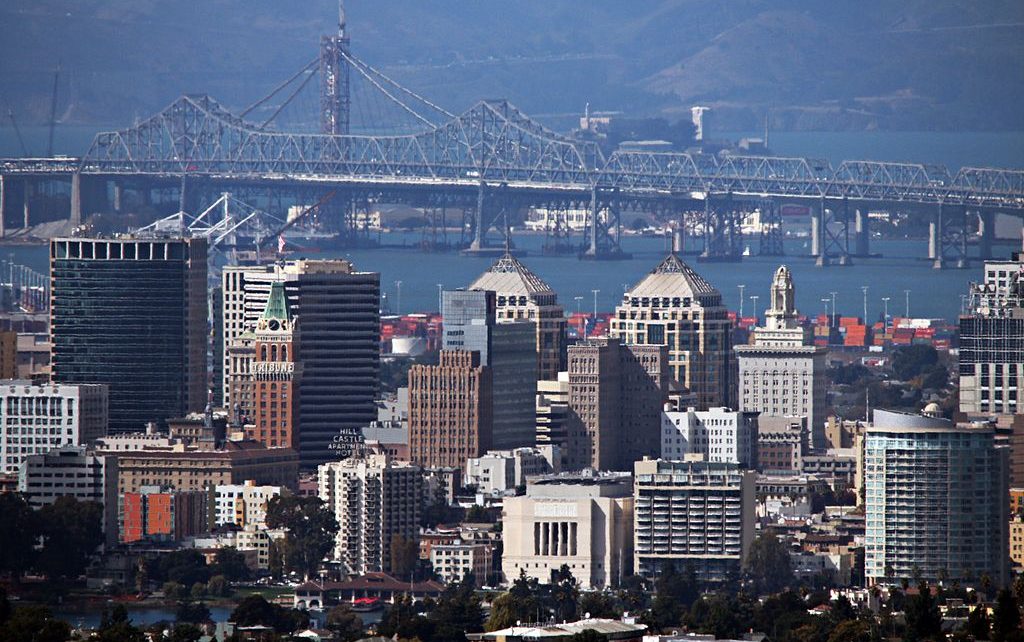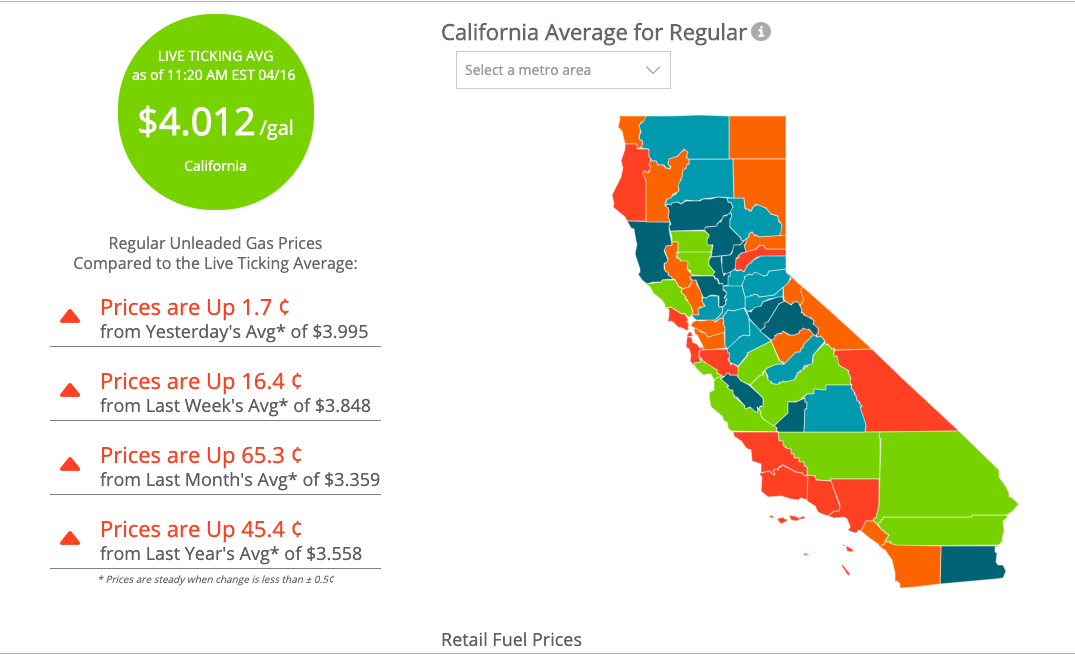
Oakland skyline
California’s Regulatory Hostility Prevents More New Homes
The hostile shake-down of builders by California’s state and local governments caused the housing shortage
By Edward Ring, June 29, 2019 7:20 am
If “NIMBYism” means stop destroying well established and tranquil low density neighborhoods with mandated high density projects, then California needs more NIMBYism, not less.
The median home price in Los Angeles County is $618,000. In Santa Clara County it’s $1.2 million. In the entire state of California, including the somewhat more “affordable” inland counties, the median home price is $548,000.
The national median home price? $227,000.
There’s a reason for this. For decades, California’s state and local governments have made it harder and more expensive for any builder to construct new housing. In most other states, the governing agencies want more housing and they try to make it easier for builders. In California, the exact opposite is the case.
The consequences of this hostile shake-down of builders by California’s state and local governments are a housing shortage, unaffordable homes, an exacerbated homeless crisis, and increased calls for rent control (which will create even more disincentives for home builders).
The response of California’s policymakers to the housing shortage they created is not to address the punitive fees and permitting delays, but to try to cram high density housing projects down the throats of local communities, accusing them of NIMBYism – the “not in my backyard” syndrome. The problem with this accusation is that no sane person wants an apartment building plopped next door to them in a neighborhood that used to be single family dwellings. If “NIMBYism” means stop destroying well established and tranquil low density neighborhoods with mandated high density projects, then California needs more NIMBYism, not less.
Along with punitive fees and permitting delays is a bias against any new housing construction on undeveloped open land, so-called “greenfield” development. The arguments against urban “sprawl” claim that wildlife habitat is threatened by new developments, ignoring the fact that California is only five percent urbanized, with plenty of room for nature preserves and new housing.
The argument that ends most discussions however, is based on the theory that the expansion of low density suburbs will result in more “greenhouse gas” emissions. This theory, even if you believe that “greenhouse gas” is a threat, is based on biased studies that fail to take into account countless variables that might call it into question, for example: job migration to exurbs to follow the new residents, less congestion on freeways, ever cleaner automobiles, and the potential to telecommute.
According to Dan Dunmoyer, president of the California Building Industry Association, California has more regulations for getting a piece of land approved than anywhere else in the world. This should come as no surprise. In California, if it only takes 10 years for a large housing development to get approval, that’s considered fast. It isn’t uncommon for it to take 20 years or more. In Nevada or Arizona, these same large projects typically get approved within 18 months.
These permitting delays drive all but a handful of very large developers out of the housing construction business in California. And along with delays from the authorities come the lawsuits, many of them based on California’s unique California Environmental Quality Act (CEQA), which environmentalists have turned into a weapon to stop housing projects in their tracks for years. And it only takes one determined environmentalist group to stop development.
A particularly egregious example of this is the proposed Tejon Ranch housing project that has been embroiled in permitting delays and lawsuits for over 25 years. This massive project, a planned community of over 19,000 badly needed new homes, would straddle Interstate 5 in the northwest corner of Los Angeles County. The developers have committed to set aside ninety percent of the land as a nature preserve, after which the NRDC, the Sierra Club, and the Nature Conservancy all withdrew their objections. But it only takes one: The “Center for Biological Diversity” has filed yet another lawsuit.
There’s nothing wrong with setting aside significant tracts of land for wildlife habitat. But when 90 percent of a parcel is not enough set-aside, and existing California law permits endless lawsuits to stop new housing developments, the laws must change. As it is, there is always another well funded environmentalist organization that will oppose all land development, anywhere in California.
While costly permitting delays drive most home builders out of California altogether, the ones that remain pay fees that are literally unbelievable. The low end of fees charged by municipalities to homebuilders are $25,000 to $30,000, usually in the inland counties. On the high end, some cities in the San Francisco Bay area charge fees of over $150,000.
As if that isn’t bad enough, these so-called “pure fees” don’t take into account the other expenses, such as hiring a consultant to determine how big to make the park relative to the other towns, or biological studies, or the purchase of nature preserves. The fees are endless – development, park, fire, infrastructure, art (yes, art), recreation. CBIA president Dunmoyer described a project in Livermore where the total cost was over a half-million dollars per lot just to pay the development fees and expenses associated with land development.
In other states, the cities and counties build parks and other infrastructure themselves, less elaborately and for far less cost, because they want housing and the economic development that comes with new residents. In California, the developer will often pay the park fee and then they don’t even build the park.
Along with the lawsuits and astronomical fees, California’s housing prices are boosted by higher materials costs. In some cases this is because of environmentalist building code mandates. The new solar energy mandates that take effect in 2020, for example, will add up to another $12,000 in additional construction cost per home. But all construction materials cost at least ten percent more in California compared to other states. California’s regulators make it extremely difficult to operate timber and quarry operations in this resource rich state, so materials have to be brought in from elsewhere at additional expense.
Contrary to what one might think, these delays and increased costs that have created sky-high housing values have not enriched the builders. Especially because they must bear the costs associated with pursuing uncertain projects which even when approved are only after decades of effort. Home builders actually make a higher rate of profit on lower priced housing in other states than they do on higher priced housing in California.
When California’s policymakers propose rent control, housing subsidies, and mandate high density housing, they are doing literally everything wrong. Rent control and subsidies will discourage private investment in housing and further undermine a competitive market for new construction. High density mandates will destroy existing neighborhoods, embittering residents, while not creating nearly enough new housing to bring supply and demand into equilibrium. Moreover, the high rise residential projects in the urban core, encouraged by policymakers, cost far more per unit because of the far greater per unit quantities of steel and concrete required for structures over a few stories in height.
The solution to California’s housing crisis is to repeal SB 375 that restricts most new housing to within the existing urban footprint, to repeal CEQA which permits endless lawsuits, and to reform pensions and other out-of-control public employee perks so operating funds – instead of insanely high fees – can help pay for infrastructure upgrades.
Crucially, the mentality of the bureaucracy has to change. They need to treat builders with respect and speed up the permitting process. Improving the attitude and performance of the bureaucracy will be the hardest thing to change, but if Californians are to have the regulatory environment for housing that they need to be able to afford to live here, that’s what’s got to happen.
As it is, California’s state and local governments engage in a shameless shakedown of anyone who wants to build anything, anywhere. Everyone is a victim of this, except for unaccountable bureaucrats who collect the fees and property taxes, and investors who speculate on the real-estate bubble. It is a scandal and a tragedy.
- Ringside: The Potential of Waste-to-Energy in California - April 17, 2024
- Ringside: How Much Water Will $30 Billion Buy? - April 10, 2024
- Ringside: Sacramento’s War on Water and Energy - April 4, 2024





We pulled permits to build a sfh in 2006. We paid 20k for county permits, 13k for school fees, 4K to PGE, 4K to the fire dept. we weren’t able to build the house for various reasons so there were no costs to any of those agencies. Fast forward and cut 1500sf off the size of the house, now the building fees are 45k, the school district fees are 35k and I haven’t even looked into the other fees. So almost a 100k in fees and the money we already paid is just money down a rat hole.
“Everyone is a victim of this, except for unaccountable bureaucrats who collect the fees and property taxes, and investors who speculate on the real-estate bubble.”
Excellent point and so true.
Someone should propose legislation that gradually reduces the population to 1970 levels. Population control similar to rent control and carbon reduction. For every person that wants to move to Cali, 3 must leave. No births without government approval. Problem solved.
Advocating in 2019 for new mass single family development over natural habitat Is an absurdity. No one with a bit of common sense can believe such a non sense in the 21th century. There is no debate anymore that. Tons of studies have scientifically demonstrated the traditional American urban model based on endless sprawl is corrupt and obsolete, a massive urbanistique failures creating absurde amount of environmental destruction, economic loss and human distress. All cities in the world are trying to get rid of cars for a good reason. Most American cities are trying to backtrack and fix their failing 50s planning policies.
Sprawl creates a disproportionate amount of greenhouse gas emissions per capita, endless commutes, social destruction, serious health problems, productivity loss. Almost all habitable land in California has been urbanized and covered with endless ugly cookie cutter developments, strip malls, parking lots and multi lane super highways. Agriculture has been pushed into arid deserts at huge cost for the environment and the people. Americans waste a disproportionate amount of time commuting in their car rather than spending this time working, or with their family; social interactions are scarce.
If cities continue to grow they can only grow responsibly in height, becoming denser to minimize commuting to the maximum and incentive people to organize all their life locally, abandon their car and walk. In 2019 it is irresponsible and egoistic to continue to push development over raw land. It is a crime against future generations.
I could not disagree more and your arrogance is both stunning and typical of the mentality you represent. The facts do not support anything you’re saying. California has vast expanses of land that is neither farmland or critical habitat. The idea that living in a detached home is unhealthy is ridiculous. You are being used.
Totally agree with what George Antrobus said
It looks like the politics and the city planners disagree with you. Massive efforts are currently underway to densify around public transportation everywhere around the country. The lifestyle you are preaching is going like the dodo way. Polls show younger generations aren’t interested in living in these single family homes
Additionally, the cities are broke and doing everything they can to scale down infrastructure
also, where are these vast expanse of land you’re talking about? in Twentynine Palms where it’s bare land and 130 degrees?
Welcome to Californication got to love liberals with their hands out.
Edward,
Thanks for the article. I spent a weekend with my 26 yr old son in San Diego 2 weeks ago. He took me to tour housing he was looking to buy in Logan Heights. After 2 hours I asked him to leave the area. I could not believe my college educated engineer who spend 3 years on a ship as a merchant marine saving $100K to buy a house and having no college debt as he attended the federal service Merchant Marine Academy at Kings Point was looking in this neighborhood for a starter home. 4 houses had foundation damage. I realized he is competing with a contractor who has the skills and equipment to fix houses or a person willing to acceot the living conditions for a price point near $440,000. So we looked at a small home in Point Loma (1100sf) with upgrades not done by a professional builder: new kitchen cabinets with doors which do not close evenly, new baseboards with finishing nail holes not patched before painting, and paint stains on hardwood floors from the final baseboard touch up. Asking $999,000. I am 58 yrs old, in good financial shape in California, but I have 4 hard working sons in their 20’s. They more than likely will be leaving the state and the Golden State of California will continue to bleed the hard working youth who realize after taking ” all the right steps” are too far behind to live a decent, middle income lifestyle in this state.
The elephant in the room is OVER POPULATION…. Until the state addresses the real issue here, the over taxed environment and quality of life will continue to decline. California cities And towns are maxed out with overdelopment (Huntington Beach, ect.)
Great column. Really, learned a lot. Hate the govt of CA.
Here is a really well written column on why people are leaving California hope that it adds to discussion. It’s why we left!
Sorry the link as to why people aren’t leaving doesn’t seem to show. Not spamming 🙂 here is the URL http://me.richtrek.com/2018/04/why-people-are-fleeing-los-angeles-and.html
Thank you for a spoon full of reality. I dont know If Hex above did not get the memo but the city does nothing to help support the problem with shortage of affordable housing. The people that try to build are raped like the tax payers but on monthly basis for years then gouged in permit fees when finally approved. Its not profitable to build in ca. anymore and if anyone needed more commute buses its LA and SF ….
I have built houses in these cities and I can attest that the city is not broke. They are rich making millions on these high density projects and taking monthly installments for the years it takes to approve them. You have to pay them monthly for years prior to a permit then pay for inspections, engineering input or any other thing. There is no support to get housing built fast and in budget. The city and fake open space , homeless fees, and parks they never build and millions to the school district for schools. The city pay for the employees/the cars. That’s it.. Nice cars.. Not roads, or new parks, or homeless housing NOTTA ..
I want to solve this problem once and for all. We need to file a massive lawsuit that redefines the word “Fees and Assessments” to what they really are = Taxes. If they were lumped into that definition and then we pass laws that require 2/3 majority to pass any new tax this problem would go away. California over taxes and over spends like there is no tomorrow. I’ve lived here for almost 40 years and it’s shameful to see how things are going.